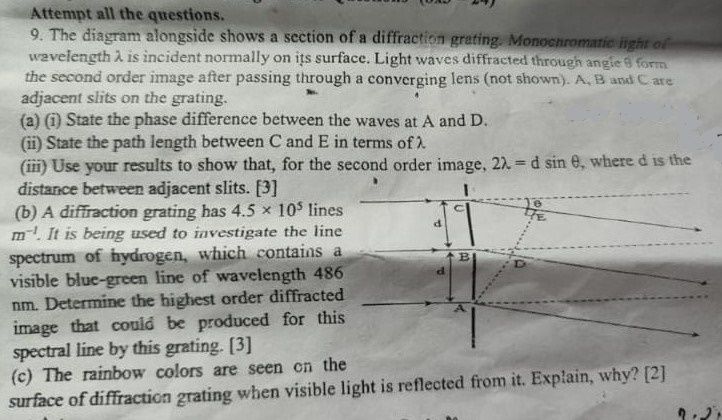CBSE Class 12-science Answered
Physics

Asked by ramdasiyogesh2001 | 12 Mar, 2021, 12:47: AM
We get diffraction from grating if the following condition is satisfied
( d sinθn ) = n λ
where d is line spacing , θn is nth order diffraction angle for light of wavelength λ and n is order of diffraction
For the given grating has 5000 lines per cm , then line spacing d = 10-2 / 5000 = 2 × 10-6 m
Wavelength of light used , λ = 6000 Ao
For first order diffraction, n = 1 , sinθ1 = λ/d = ( 6000 × 10-10 ) / ( 2 × 10-6 ) = 0.3
For second order diffraction, n = 2 , sinθ2 = 2 λ/d = ( 2 × 6000 × 10-10 ) / ( 2 × 10-6 ) = 0.6
For third order diffraction, n = 3 , sinθ3 = 3 λ/d = ( 3 × 6000 × 10-10 ) / ( 2 × 10-6 ) = 0.9
For higher order , sinθn > 1 , which is not possible
we get maximum 3 order spectrum with the given gratings and wavelength used
Answered by Thiyagarajan K | 12 Mar, 2021, 04:23: PM
Concept Videos
CBSE 12-science - Physics
Asked by prachis14 | 06 Mar, 2023, 04:49: PM
CBSE 12-science - Physics
Asked by suman.sh01 | 21 May, 2022, 11:09: AM
CBSE 12-science - Physics
Asked by arjunsah797 | 14 May, 2022, 01:34: PM
CBSE 12-science - Physics
Asked by sirib942254 | 04 Aug, 2021, 08:30: PM
CBSE 12-science - Physics
Asked by ramdasiyogesh2001 | 12 Mar, 2021, 12:47: AM
CBSE 12-science - Physics
Asked by dsdeepak487 | 27 Feb, 2020, 06:06: PM
CBSE 12-science - Physics
Asked by Abhineet | 26 Nov, 2019, 02:04: AM
CBSE 12-science - Physics
Asked by Abhineet | 26 Nov, 2019, 02:03: AM
CBSE 12-science - Physics
Asked by vanshrathod71 | 30 Jan, 2019, 12:38: PM
CBSE 12-science - Physics
Asked by Topperlearning User | 13 Jun, 2014, 07:29: AM







